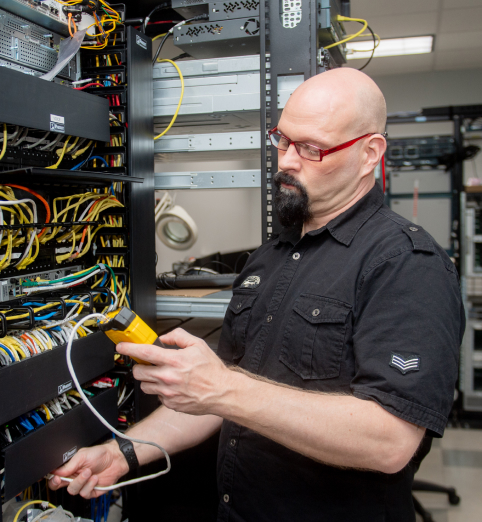Optical Networking for Tomorrow: How to Ready Your IT Hardware for the Future
The use of optical networks grew exponentially in the past few years and are now one of the leading telecommunications networks. These networks have a clear advantage compared to their predecessors, such as copper cabling and radio spectrum. Optical networks provide lower latency, higher bandwidth, and faster transmission of data. (It’s like your smartphone compared to your flip phone of the past.)
As a data super-highway, optical networks, along with 5G, are enabling AI and the Internet of Things (IoT) to change the business landscape. With AI and the IoT becoming more a part of our modern-day reality, businesses using these applications will be consuming and analyzing more and more data. Is your network ready for what’s coming? Read on to see how you can prepare for this digital revolution.
How AI and IoT Are Disrupting the Business Landscape
When many people think of AI, the first thought that comes to mind may be a science-fiction movie where robots are taking over the world (ahem, Agent Smith). Thankfully, that’s not what we’re talking about here (well, not yet anyway). Although AI is becoming increasingly mainstream, like Alexa in your home, its disruptive power can be found mainly in how it will process business data.
Utilizing Data: AI, with its machine-learning algorithms, will be able to sift through large amounts of data and provide groundbreaking insights into customer behavior; it will be able to collect and analyze information and identify patterns in ways that have been unparalleled until now.
Decisioning: With these key insights, AI will be able to make decisions with swift speed. For example, for utilities companies, it’ll be able to use customer data to forecast peak usage times in the future, allowing their systems to make power decisions and avoid things like black-outs..
Customer Service: We know how important customer service is for retaining customers, and AI will play an even greater role in dealing with consumers. In our post-pandemic era, more people are choosing the web to make their purchases, which means customer service expectations are even more important for e-commerce.
Have you come across any chatbots when arriving at a company website? (Of course, you have!) Many of those chatbot features rely on AI to answer basic customer questions, helping maintain customer loyalty by providing solutions in real-time. With more online purchasing, virtual assistants will become the norm rather than the exception, helping businesses transition into using more AI within their customer service features.
Autonomous Vehicles: Along with AI, we can also expect the IoT landscape to expand as we see more autonomous vehicles on the road. The companies of the future are already investing in driverless cars. Similar to the way our smartphones can connect with each other, autonomous cars will be able to connect and exchange data (such as GPS signals) to identify and predict traffic patterns.
Autonomous vehicles are just one example (and the most popular) of smart machinery. Smart machinery is often tied to automation and robotics (yup, we’re bringing robots back into the picture now!). Think of it as “cognitive machinery” that can learn, adapt, and make decisions on its own. For this reason, smart machinery will be found in many manufacturing plants.
Smart Grids: Think of smart grids as the new kid on the block when it comes to electricity. By combining advanced technology, the IoT, and digital channels, smart grids allow for a two-way flow of electricity to customers, where data on electricity usage is sent back to the main grid. Smart grids are commonly connected to smart buildings. … Which leads us to our next topic.
Smart Buildings: We can also expect more smart buildings– so much more. By 2026, smart buildings will reach 115 million! So, we’re not talking hyperboles here. Smart buildings connect to smart grids and use the combination of the wired IT infrastructure with wifi access points to deliver electricity. They have AI-driven sensing devices which enable lots of benefits. To start with, it decreases energy costs and increases energy efficiency. These sensors also optimize indoor air quality, regulate temperature, and control humidity. If you happen to work inside a smart building, you can thank AI for the comfy environment and cost savings.
Why Having an Optical Network Will Be Necessary to Support AI and IoT
With optical networks, there are almost no limitations on the amount of data that they can handle. But let’s keep in mind that no matter how advanced the AI application may be, it can’t be maximized if a network can’t support it. With their high-bandwidth capabilities and low latency, optical networks can ensure that your AI applications run smoothly.
In addition to the optical network, most AI apps entering the digital marketplace will also need 5G. Nowadays, we can’t talk about data without mentioning 5G and for good reason. The main benefit that 5G has over its predecessor 4G is lower latency – the equivalent of higher bandwidth. By supporting higher bandwidth, 5G will be able to make sure that your apps are working perfectly, all the while connecting an unprecedented number of devices to each other and expanding our IoT reality.
Because AI lives on the web (whether it’s through desktop, mobile, or through an app), having reliable connectivity is very important. If we go back to our example of using a virtual assistant, imagine what would happen if the internet connection goes down. Having an optical network and 5G in place ensures that your connectivity is covered.
Prepping Your Network So That It’s Ready for AI and 5G
Getting ready for the AI and IoT revolution means having a strategy in place. Here are some tips that you can start right away:
- Make Room for App Partnerships
As the IoT world expands, we’ll see more collaboration between companies via AI applications. Assess your own current network (upgrade to 5G if you haven’t already) and make sure that it’s configured to work with 3rd-party applications.
- Focus on Security
More data and connected devices often leaves more opportunities for security breaches. For hackers, “phishing season” is every season of the year! To make sure that your data isn’t vulnerable to cyber threats, consult cyber experts who will make sure you have a comprehensive security plan.
- Maximize the Use of Your Data
So. much. data. What to do with it is often the issue. Many businesses collect a wealth of data but they often aren’t able to identify meaningful trends. But with AI, you’ll get a close-up look at how your customers are using your services. Where are the majority of your customers located? When are the peak hours of usage? How much of your service is used during those peak hours? You’ll be able to answer those questions and more if you devise a plan for leveraging the data. By seeing the big picture, along with the nitty gritty details, you’ll be able to fine-tune your services to your business goals.
- Budget for the Future
Have a budget in place so that you can invest in these technological changes. As more companies gravitate toward AI, 5G, and IoT, you want to do the same to remain competitive. Optical network consultants like our engineers at Inteleca can assist you with a plan to meet your business goals.
Along with these digital bite-sized tips, speak with experts and get recommendations for creating a comprehensive strategy. If you need help with your network strategy, our engineers can assist you – no matter what the scope or size. From implementation and beyond, we tailor the solution specifically to your business needs. If you want a consultation, contact us today.



